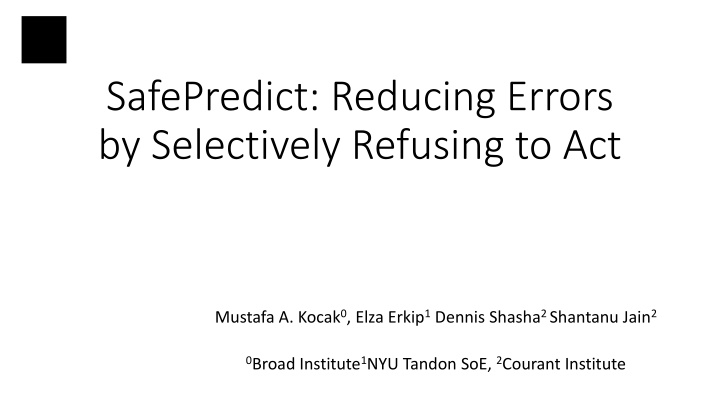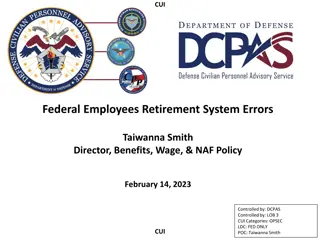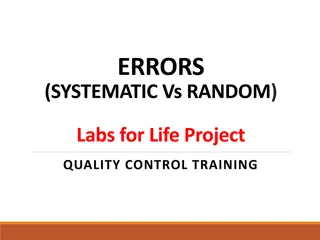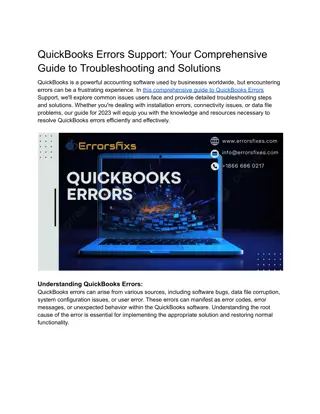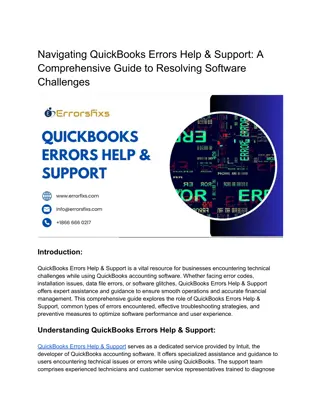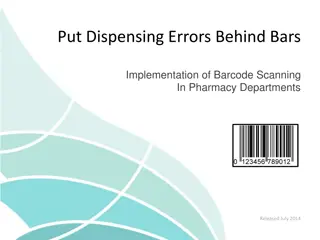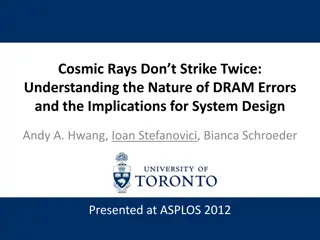SafePredict: Reducing Errors
Adaptive strategies in machine learning, such as SafePredict and Forgetful Forests, help reduce errors caused by concept drift in various domains like recommender systems and finance. Tools like neural networks and random forests are designed to adapt to changing data over time, enhancing prediction accuracy. By selectively refusing to predict in certain instances, these methods improve decision-making and reduce costly errors.
Download Presentation

Please find below an Image/Link to download the presentation.
The content on the website is provided AS IS for your information and personal use only. It may not be sold, licensed, or shared on other websites without obtaining consent from the author.If you encounter any issues during the download, it is possible that the publisher has removed the file from their server.
You are allowed to download the files provided on this website for personal or commercial use, subject to the condition that they are used lawfully. All files are the property of their respective owners.
The content on the website is provided AS IS for your information and personal use only. It may not be sold, licensed, or shared on other websites without obtaining consent from the author.
E N D
Presentation Transcript
SafePredict: Reducing Errors by Selectively Refusing to Act Mustafa A. Kocak0, Elza Erkip1Dennis Shasha2 Shantanu Jain2 0Broad Institute1NYU Tandon SoE, 2Courant Institute
Motivation o Making a bad decision can be costly o an unnecessary medical operation, a bad trade in finance. o Most of medicine is i.i.d. (independent identically distributed). One patient has same causal factors as other. /29 2
Concept Drift in Several Domains o Recommender systems must change over time, e.g. if I go to a movie recommendation system, it should not recommend Casablanca if I m looking for a recent release. o Epidemic spreads can change as the epidemic evolves. o Financial decisions can be independent of politics often, but what about around election time? /29 3
Tools at Our Disposal o (i) Machine learning methods that adapt over time. o (ii) Ensemble algorithms that can weight different algorithms. o (iii) Confidence-based prediction based on self-evaluation of predictors. o (iv) SafePredict to refuse to predict sometimes. /29 4
Neural Nets adaptive by design o Neural nets use an updating algorithm called gradient descent: each prediction is compared with the correct answer and weights are adjusted if there are errors. o Thus feedback is continuous. o So, neural nets are adaptive to concept drift by design. o However . Not always the most accurate choice. /29 5
Random Forests can be made adaptive o A random forest is a collection of decision trees (or if we want a continuous outcome, classification and regression trees), each on randomly chosen subset of data features. o Normally (for i.i.d. data), train once and use forever. o Adaptation strategy idea: If a tree or trees are often wrong, rebuild based on recent data. We call those Forgetful Forests. /29 6
Tools at Our Disposal o (i) Machine learning methods that adapt over time. o (ii) Ensemble style algorithms that can weight different algorithms. o (iii) Confidence-based prediction based on self-evaluation of predictors. o (iv) SafePredict to refuse to predict sometimes. /29 7
Adjusting Weights Among Machine Learning Algorithms o Suppose you have several machine learning algorithms, e.g. different neural nets, several random forests, others. o Evaluate predictions of each machine learning method. o Adaptation strategy (ensemble idea): If one method does better than others, then give it more weight. o Similar to adaptive random forests except that one adjusts weights given to algorithms rather than changing the algorithms themselves. /29 8
Tools at Our Disposal o (i) Machine learning methods that adapt over time. o (ii) Ensemble style algorithms that can weight different algorithms. o (iii) Confidence-based prediction based on self-evaluation of predictors. o (iv) SafePredict to refuse to predict sometimes. /29 9
Conformal Prediction Train & Calibration o Split training set into core and calibration sets. o In calibration set, find fraction of trees that must agree to make prediction that exceeds correctness target (e.g. 90%). o If a given data point gets insufficient votes, refuse. Conforming Non-conforming /29 11
Accuracy refusal tradeoff Can cut the error rate for iid (independent identically distributed) o in half by refusing 6 - 32% of the time. o to a quarter by refusing 12-57% of the time. /29 12
Tools at Our Disposal o (i) Machine learning methods that adapt over time. o (ii) Ensemble style algorithms that can weight different algorithms. o (iii) Confidence-based prediction based on self-evaluation of predictors. o (iv) SafePredict to refuse to act sometimes. /29 13
What if not Independent Identically Distributed (iid), i.e. you have concept drift? o In that case conformal prediction (self-confidence of predictor) may be false. ( We re not in Kansas anymore ) o Your friend tells you he loves some movie, but you realize your tastes have changed and you don t want to see another action movie without character development. . /29 14
Idea of SafePredict o Basic idea is to use base predictor or predictors perhaps with an ensemble method while everything is good. o Confidence-based (conformal) prediction to accept those predictions only if self-confidence is high o SafePredict intervenes if error rate is too high, perhaps due to concept drift o Can give asymptotic guarantees even against an adversary. /29 15
What Does Working Mean? o Validity guarantee (asymptotic): Will get desired error rate on non- refused predictions (fine print in next slide). o Efficiency: if error rate is in fact below desired error rate, will accept almost all predictions. /29 16
Dealing with the Adversary specific goals o Adversary is powerful: knows when you will refuse and when you won t o So adversary can foil any specific predictor no matter how confident. But if adversary causes predictor to be wrong above error bound you will accept the prediction almost never. o Guarantee is that if number of non-refused predictions approaches infinity, then will meet error bound on those. /29 17
Dealing with the Adversary mechanics o Set up a two-bandit setting where with some probability, act based on output of the confidence-based predictor, but otherwise don t act on the prediction. o If the confidence-based predictor is correct, then give it higher probability. Otherwise give the refusing bandit higher probability. o Adjust learning rate using the doubling trick . /29 18
At time ? = 1,,?: 1.Environment reveals ?? 2.Adaptive predictor(s) P makes prediction: ??, computes reliability score: ?? 3.Confidence Based Rejection (CBR) rejects based on ?? 4.Combine based on bandits. 5.SafePredict (SP) decides on whether to accept. 6.Ground truth ??is revealed, CBR and SP updates their inner states. Algorithm Parameters: target error rate ?, CBR window size: w /29 19
Recovering from Excessive Refusals o Your friend has given you three bad movie recommendations so you don t listen any more o Issue: get into a regime in which you never listen to your friend, but what if his tastes also change and he likes French movies. o Resolution: weight-shifting accept predictions on occasion even if predictions have been bad. /29 20
/29 21
/29 23
SafePredict Implementation (Shantanu Jain) o SafePredict is implemented as a meta-estimator in the popular Python framework scikit-learn. o It works out-of-the-box with the same familiar scikit-learn API with methods like .fit(), .partial_fit(), .predict() and can be directly integrated into existing analysis pipelines. o The implementation acts like a wrapper around scikit-learn estimators, just adding the possibility to refuse predictions. /29 24
/29 25
SafePredict Parameters Target error: Required upper bound on error rate. Horizon: Total number of data points to be predicted Alpha: Strict lower bound on probability that SafePredict accepts a prediction. (Validity of SafePredict is probabilistically guaranteed when alpha is on the order of 1/Horizon) Refusal class: The required output indicating that a prediction is refused Calibration: Addition of calibration method (Platt/Isotonic) for confidence-based refusals in addition to SafePredict /29 26
SafePredict Implementation o Github repo: https://github.com/ShanJ35/SafePredict o Medium Blog post with example: https://medium.com/@sj2538/safepredict-asymptotic-error- bounds-for-online-learning-c02da4e4b846 /29 27
Summary o Concept Drift is an issue in many fields (causal factors can change) o Machine learning algorithms can be made adaptive. o Ensemble method to weight among them can also be adaptive. o ConformalPrediction looks at confidence of algorithm to accept prediction or not. o SafePredict uses previous error rate to accept or not. o Weight shifting to avoid getting stuck. /29 28
References Good performance against adversaries: https://ii.uni.wroc.pl/~lukstafi/pmwiki/uploads/AGT/Prediction_Learning _and_Games.pdf N. Cesa-Bianchi, Y. Mansour, and G. Stoltz, Improved Secondorder Bounds for Prediction with Expert Advice, Machine Learning, vol. 66, no. 2-3, pp. 321 352, 2007. o Conformal Prediction: V. Vovk, A. Gammerman, and G. Shafer, Algorithmic Learning in a Random World. Springer Sci. & Bus. Media, 2005. /29 29
